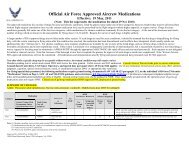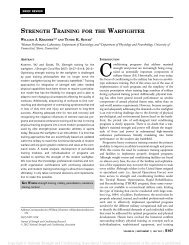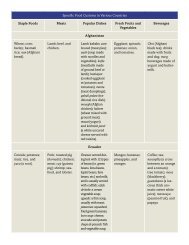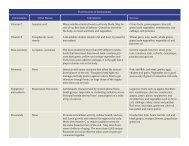Force Health Protection: Nutrition and Exercise Resource Manual
Force Health Protection: Nutrition and Exercise Resource Manual
Force Health Protection: Nutrition and Exercise Resource Manual
Create successful ePaper yourself
Turn your PDF publications into a flip-book with our unique Google optimized e-Paper software.
Walking<br />
Walking is the easiest, most common, low impact exercise<br />
that people engage in. However, there are many misconceptions<br />
about the usefulness of walking for weight loss <strong>and</strong><br />
cardiorespiratory conditioning. These health benefits can be<br />
realized by walking, as long as the intensity is high enough to<br />
increase your heart rate to 60-75% of your max HR (Worksheet<br />
5-1).<br />
When you walk, keep your back straight <strong>and</strong> your stride comfortable. Do<br />
not use ankle or h<strong>and</strong> weights because they increase the stresses placed<br />
on your joints, especially as you quicken your pace. If you have been<br />
sedentary <strong>and</strong> would like to begin a walking program, start by walking on a<br />
flat surface. Walk for 15 minutes at a pace that allows you to talk somewhat<br />
easily. Walk every other day. Each week increase the time you walk by 10%<br />
until you can walk for 20 minutes continuously. Once you can comfortably<br />
walk for 20 minutes, increase your pace by no more than 10% each week until<br />
you can walk 1 mile in 20 minutes (3 m.p.h. pace). Once you reach this point,<br />
hold your pace <strong>and</strong> gradually increase your distance (by no more than 10%<br />
each week) until you can walk 2 miles. Once you have reached this point, try<br />
the walking program outlined in Table 6-1.<br />
Table 6-1. Outline of a Walking Program<br />
Weeks<br />
Frequency<br />
times/week<br />
Miles<br />
Goal Time<br />
(min)/ pace<br />
Comments<br />
1-2 3 2.0 40 min / 3.0 m.p.h* Quicken your pace by<br />
3-4 4 2.0 38 min / 3.2 m.p.h.<br />
1 min each week<br />
5-6 5 2.0 36 min / 3.3 m.p.h.<br />
7 5 2.0 34 min/ 3.5 m.p.h. Increase your distance<br />
8 5 2.5 43 min/ 3.5 m.p.h.<br />
by 1/2 mile each week<br />
9 5 3.0 51 min/ 3.5 m.p.h.<br />
10-15 5 3.0 45 min/ 4.0 m.p.h.<br />
16-17 4 3.5 53 min/ 4.0 m.p.h.<br />
18-19 4-5 4.0 60 min/ 4.0 m.p.h.<br />
Adapted from OPNAVINST 6110.1D Jan. 1990. *m.p.h. = miles per hour.<br />
You can maintain a walking program indefinitely <strong>and</strong> reap the health <strong>and</strong><br />
fitness benefits. Once you can walk 60 minutes at a 4 m.p.h. pace, add hills<br />
or inclines to vary your exercise intensity, add variety to your routine, <strong>and</strong><br />
to combat boredom. The key to maintaining your aerobic fitness level is to<br />
maintain your walking intensity between 60% <strong>and</strong> 75% of your max HR.<br />
<strong>Nutrition</strong> <strong>and</strong> <strong>Exercise</strong> <strong>Resource</strong> <strong>Manual</strong> 47






![Body Composition and Military [PDF] - Human Performance ...](https://img.yumpu.com/43269347/1/190x245/body-composition-and-military-pdf-human-performance-.jpg?quality=85)
![Tips for Grocery Shopping [PDF]](https://img.yumpu.com/37447379/1/190x245/tips-for-grocery-shopping-pdf.jpg?quality=85)



![Synthetic Drugs [PDF] - Human Performance Resource Center](https://img.yumpu.com/37447322/1/190x245/synthetic-drugs-pdf-human-performance-resource-center.jpg?quality=85)


